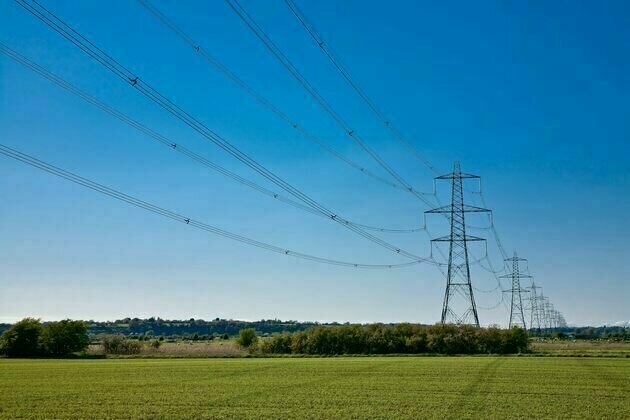'Pylon wars' show why big energy plans need locals on board
The Conversation
07 Jul 2025, 16:34 GMT+10

Thousands of new electricity pylons are to be built across parts of England under the government's plans to decarbonise the electricity. And some people aren't happy.
A glance at recent Daily Telegraph articles seem to suggest most of the genteel English countryside is about to be taken over by evil metal monsters. Headlines talk of "noisy" pylons set to "scythe through" "unspoiled countryside", leading to a "pylon penalty" for house prices and even "mass social unrest".
While some of the stories are rather over the top, they reflect a genuine unease, and there have been significant campaigns against pylons. In Suffolk, for instance, resistance is building against plans for a 114-mile-long transmission line connecting new offshore wind farms to Norwich and beyond.
So why do these towering steel structures evoke such powerful feelings?
Get your news from actual experts, straight to your inbox. Sign up to our daily newsletter to receive all The Conversation UK's latest coverage of news and research, from politics and business to the arts and sciences.
Pylons have had a particular fascination since they were first introduced in the 1920s. Even then, the biggest challenge was to get "wayleaves" (permission) to cross farmland. To calm rural protest groups, the government's electricity board commissioned an architect, Reginald Blomfield, to design transmission towers with an eye to "visual amenity".
In the most protected areas, expensive underground cabling was used to hide the transmission lines altogether. The board used its copious marketing materials to emphasise that this option was around six times more expensive, and therefore only for exceptional use. By the 1940s pylons were much cheaper than underground cables, providing a techno-economic rationale that remains politically persuasive today.
One reason pylons are so controversial is related to a particularly English fascination with landscape. The geographer David Matless wrote some years ago of the "powerful historical connection" between Englishness and a vision of its countryside. People feel a degree of ownership over a varied landscape, encompassing lowland and upland, north and south, picturesque and bleak, and often have strong opinions about what "fits", what constitutes "heritage" and what is "out of place".
Even if most of England is privately owned and commercially farmed, many people still imagine the land as a public good tied to national sentiments and see pylons as intruders in the landscape.
This could also explain why proposals to build infrastructure across the English countryside often provoke significant objections. My research on planning in the Home Counties (the areas surrounding London) back in the 1990s revealed a very determined population of well-educated and well-resourced people willing to spend significant amounts of time and money ensuring that the landscape met their expectations.
Concerted efforts had seen off a proposal from the then Conservative government to build a motorway through the Chiltern Hills to the west of London, for example.
There were, and still are, innumerable village groups willing to turn up to public enquiries and to pay lawyers to launch appeals and legal challenges. They may have been sceptical of the more grungy road protesters (historically embodied by the indomitable Swampy), but there was certainly common purpose.
My conclusion at the time was never to underestimate the effectiveness of local action where people's vision of the English countryside was challenged. More recently, plans to run the HS2 rail line through those same hills ran into fierce local opposition, which prompted significant redesigns.
That's all well and good, but today we face catastrophic climate change and biodiversity loss. Wind turbines are one of the most effective ways to decarbonise electricity supplies, but they are in different places from the old coal and gas power stations. Ironically, the same love of landscape that pushed wind farms out to sea now fuels opposition to the cables that bring the power back to land.
One of the challenges here is that decisions over things like high-voltage transmission lines are based on models that seek to "optimise" the design of equipment, on the basis of cost or effectiveness, or both. These models have no way to account for landscape and heritage value or aesthetics and should never be the sole basis for decisions about infrastructure.
Running pylons across Suffolk might be the cheapest route with least electrical loss, but is it the best option? What would the alternatives be? Starting the discussion from the basis of techno-economic modelling often preempts a properly balanced debate.
This isn't an argument for or against big pylons. It's a call for more democratic planning and not less.
Studies consistently show that people resent being excluded from decisions that reshape their landscape and environment. Planning is a political process, and in any such process, humiliating your opponent rarely leads to long-term harmony.
Top down decisions about "national infrastructure" may save time on paper but are not a good way to make progress. It appears autocratic and shifts objectors onto the streets or into the courts.
Real consultation takes time and effort. But it builds trust and leads to better outcomes.
Maybe pylons are the least-worst option. Maybe not. But we won't know unless we ask - and listen.
Don't have time to read about climate change as much as you'd like?
Get a weekly roundup in your inbox instead. Every Wednesday, The Conversation's environment editor writes Imagine, a short email that goes a little deeper into just one climate issue. Join the 45,000+ readers who've subscribed so far.
 Share
Share
 Tweet
Tweet
 Share
Share
 Flip
Flip
 Email
Email
Watch latest videos
Subscribe and Follow
Get a daily dose of Massachusetts Sun news through our daily email, its complimentary and keeps you fully up to date with world and business news as well.
News RELEASES
Publish news of your business, community or sports group, personnel appointments, major event and more by submitting a news release to Massachusetts Sun.
More InformationInternational
SectionCongress weighs Medicaid cuts, sparking alarm in small-town hospitals
OMAHA, Nebraska: With Congress considering cuts totaling around US$1 trillion to Medicaid over the next decade, concerns are rising...
Gas station blast injures 40 in Rome, kids narrowly escape
ROME, Italy: Quick thinking by emergency responders helped prevent greater devastation after a gas station explosion in southeastern...
Weapons pause by Trump signals shift away from foreign wars
WASHINGTON, D.C.: President Donald Trump is drawing praise from his core supporters after halting key arms shipments to Ukraine, a...
Moscow removes Taliban from banned list, grants official status
MOSCOW, Russia: This week, Russia became the first country to officially recognize the Taliban as the government of Afghanistan since...
Netanyahu vows 'No Hamas' in postwar Gaza amid peace talks
CAIRO, Egypt: This week, both Hamas and Israel shared their views ahead of expected peace talks about a new U.S.-backed ceasefire plan....
US sends message by publicizing visa ban on UK punk-rap band
WASHINGTON, D.C.: The Trump administration has made public a visa decision that would usually be kept private. It did this to send...
Business
SectionTrump admin allows GE to restart engine sales to China’s COMAC
WASHINGTON, D.C.: The U.S. government has granted GE Aerospace permission to resume jet engine shipments to China's COMAC, a person...
Saudi Aramco plans asset sales to raise billions, say sources
DUBAI, U.A.E.: Saudi Aramco is exploring asset sales as part of a broader push to unlock capital, with gas-fired power plants among...
Russia among 4 systemic risk countries for Italian banks
MILAN, Italy: Italian regulators have flagged four non-EU countries—including Russia—as carrying systemic financial risk for domestic...
US debt limit raised, but spending bill fuels fiscal concerns
NEW YORK CITY, New York: With just weeks to spare before a potential government default, U.S. lawmakers passed a sweeping tax and spending...
Shein hit with 40 million euro fine in France over deceptive discounts
PARIS, France: Fast-fashion giant Shein has been fined 40 million euros by France's antitrust authority over deceptive discount practices...
Meta hires SSI CEO Gross as AI race intensifies among tech giants
PALO ALTO/TEL AVIV: The battle for top AI talent has claimed another high-profile casualty—this time at Safe Superintelligence (SSI),...













